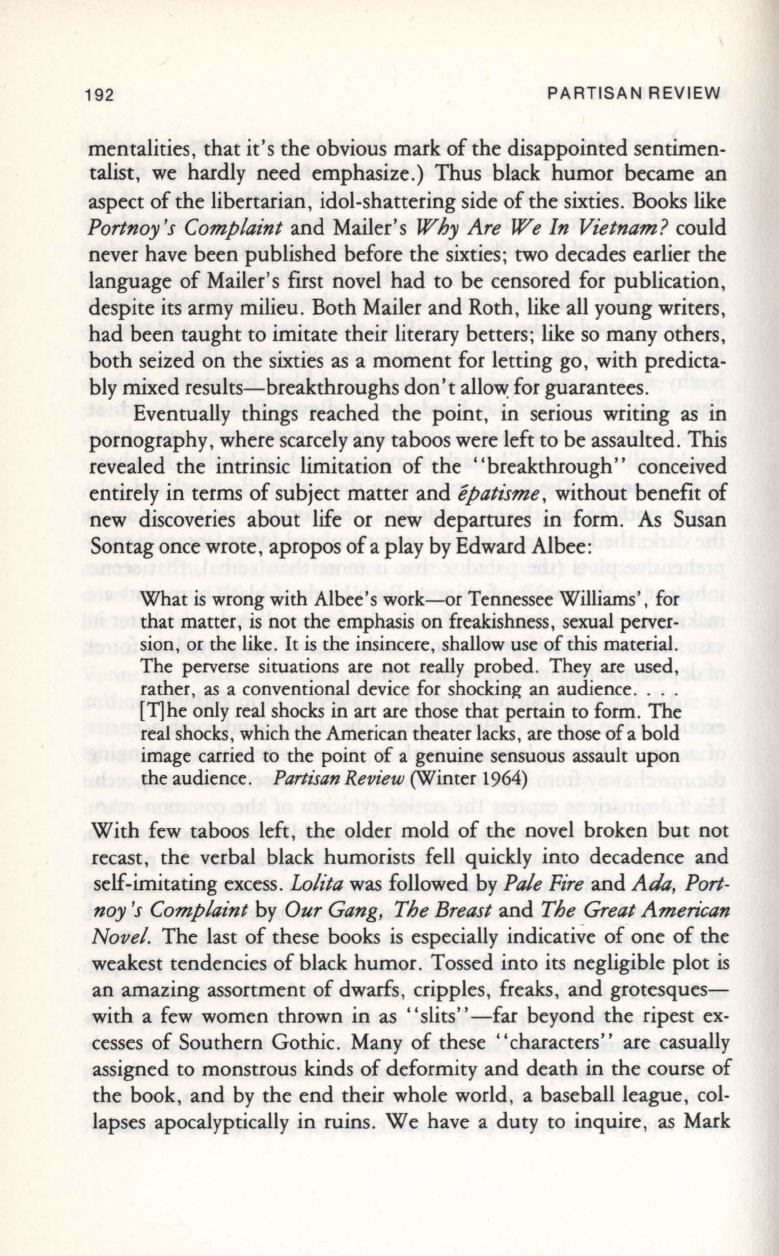
192
PARTISAN REVIEW
mentalities, that it's the obvious mark of the disappointed sentimen–
talist, we hardly need emphasize.) Thus black humor became an
aspect of the libertarian, idol-shattering side of the sixties. Books like
Portnoy's Complaint
and Mailer's
Why Are We In Vietnam?
could
never have been published before the sixties; two decades earlier the
language of Mailer's first novel had
to
be censored for publication,
despite its army milieu. Both Mailer and Roth, like all young writers,
had been taught to imitate their literary betters; like so many others,
both seized on the sixties as a moment for letting go, with predicta–
bly mixed results-breakthroughs don't allov.: for guarantees.
Eventually things reached the point, in serious writing as in
pornography, where scarcely any taboos were left to be assaulted. This
revealed the intrinsic limitation of the "breakthrough" conceived
entirely in terms of subject matter and
epatisme,
without benefit of
new discoveries about life or new departures in form. As Susan
Sontag once wrote, apropos of a play by Edward Albee:
What is wrong with Albee's work-or Tennessee Williams', for
that matter, is not the emphasis on freakishness, sexual perver–
sion, or the like.
It
is the insincere, shallow use of this material.
The perverse situations are not really probed. They are used,
rather, as a conventional device for shocking an audience....
[T]he only real shocks in art are those that pertain to form. The
real shocks, which the American theater lacks, are those of a bold
image carried
to
the point of a genuine sensuous assault upon
the audience.
Partisan Review
(Winter
1964)
With few taboos left, the older mold of the novel broken but not
recast, the verbal black humorists fell quickly into decadence and
self-imitating excess.
Lolita
was followed by
Pale Fire
and
Ada, Port–
noy's Complaint
by
Our Gang, The Breast
and
The Great Amencan
Novel.
The last of these books is especially indicative of one of the
weakest tendencies of black humor. Tossed into its negligible plot is
an amazing assortment of dwarfs, cripples, freaks, and grotesques–
with a few women thrown in as "slits" -far beyond the ripest ex–
cesses of Southern Gothic. Many of these "characters" are casually
assigned to monstrous kinds of deformity and death in the course of
the book, and by the end their whole world, a baseball league, col–
lapses apocalyptically in ruins. We have a duty
to
inquire, as Mark


